Nike unveils Vomero Premium and Vomero Plus for the ultimate running and walking experience

One of my goals for the rest of the year is to actually start the thing that I promised myself I would start at the beginning of 2025: running, or at least brisk walking. One of the problems that I faced before, when I was still doing that, was that I did not invest in good running shoes. The ones I used were either not that comfortable or would show wear and tear just a few weeks in. Nike has been recommended to me many times, and seeing that they will soon be releasing next-level sneakers may encourage me to finally invest in a pair.
Nike has announced the next level of comfort and performance in running shoes with their Vomero Premium and Vomero Plus. These two new silhouettes build on the beloved Vomero line, a favorite among runners and casual wearers who crave plush cushioning and all-day support. Both are engineered to make running and walking easier on the body, highlighting their advanced midsole technology.
Designer: Nike


The Vomero Premium features the brand’s prized ZoomX foam, which is the same responsive, lightweight material used in their elite racing shoes. This provides a soft and bouncy feel when you’re running or walking, absorbing impact and returning energy. Each step feels lighter and won’t leave you with that heavy, tired feeling as your run goes on. It’s designed to meet the needs of elite marathon runners and is considered the ultimate recovery trainer. It has a plush 55-millimeter heel stack height and gives you maximum cushioning for those recovery miles as well as your easy runs.




The Vomero Plus, meanwhile, has the full ZoomX midsole, so you get an even softer, lighter, and more responsive ride. The silhouette comes with a 45-millimeter heel stack height and an evolved version of the most responsive foam, giving you around 85% energy return. It’s recommended for longer runs and for those who want to increase their mileage and get a comfortable recovery shoe. The Vomero Plus features a thoughtfully engineered midsole with increased rocker geometry and a wide platform, delivering an ultra-cushioned sensation while maintaining responsiveness and stability. Its upper is crafted from soft, stretchy engineered mesh, offering enhanced comfort around the collar and tongue. The high-abrasion rubber outsole ensures reliable traction for high-mileage runs.




Nike hasn’t skimped on the upper materials either. Both models sport engineered mesh uppers that hug your feet without feeling restrictive. The Premium version ups the ante with luxurious fabrics and thoughtful overlays that add structure while keeping things breathable. These shoes are designed to mold to your foot’s movements, reducing the chance of hot spots or discomfort on longer outings. While these shoes are engineered for running, their comfort and style make them perfect for everyday wear. The plush underfoot feel is gentle on joints, and the durable rubber outsole provides great traction whether you’re jogging on the pavement or strolling through the park. The Vomero Plus is set to release this August, while the Vomero Premium will be available by October.




The post Nike unveils Vomero Premium and Vomero Plus for the ultimate running and walking experience first appeared on Yanko Design.



































































































































































